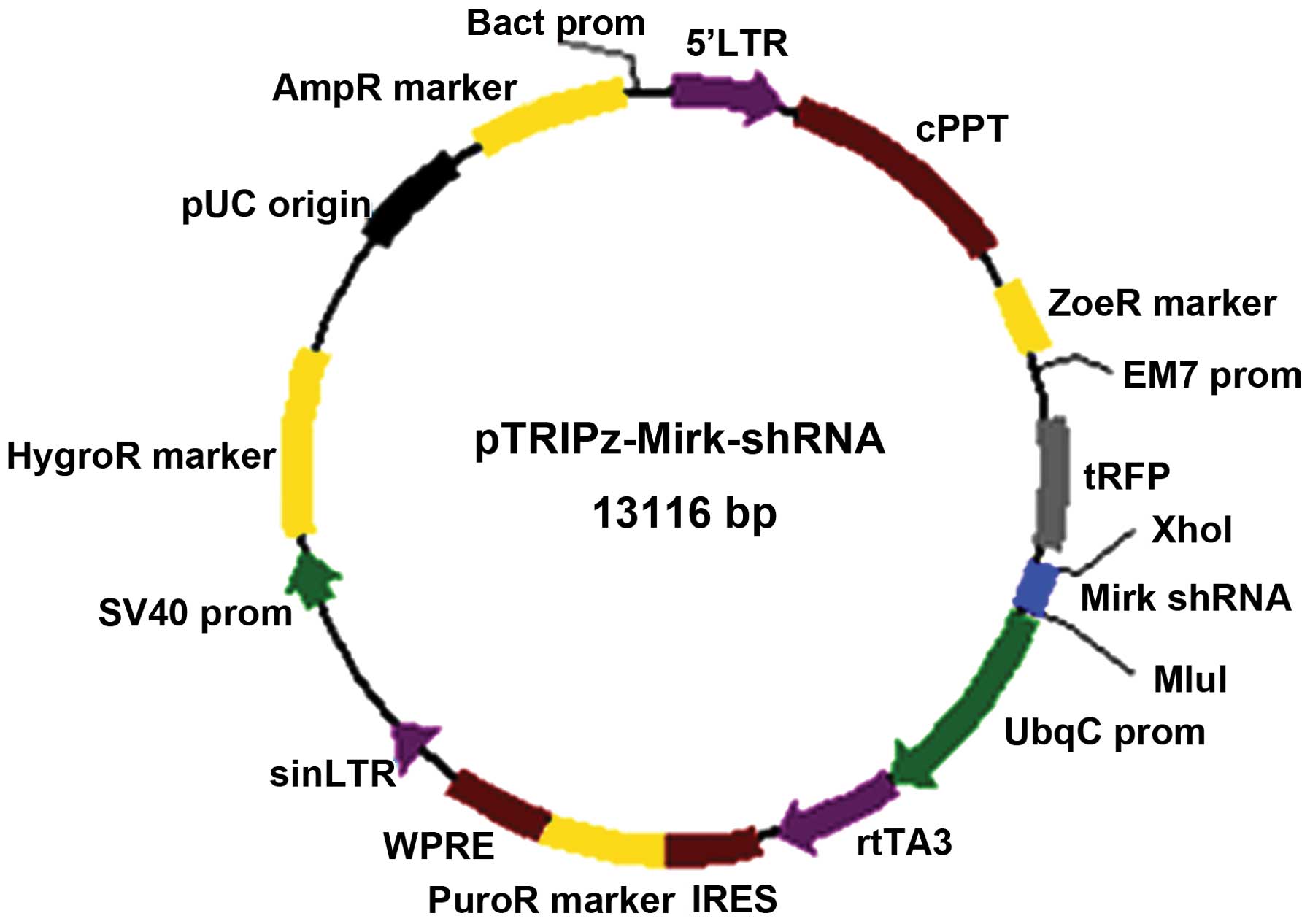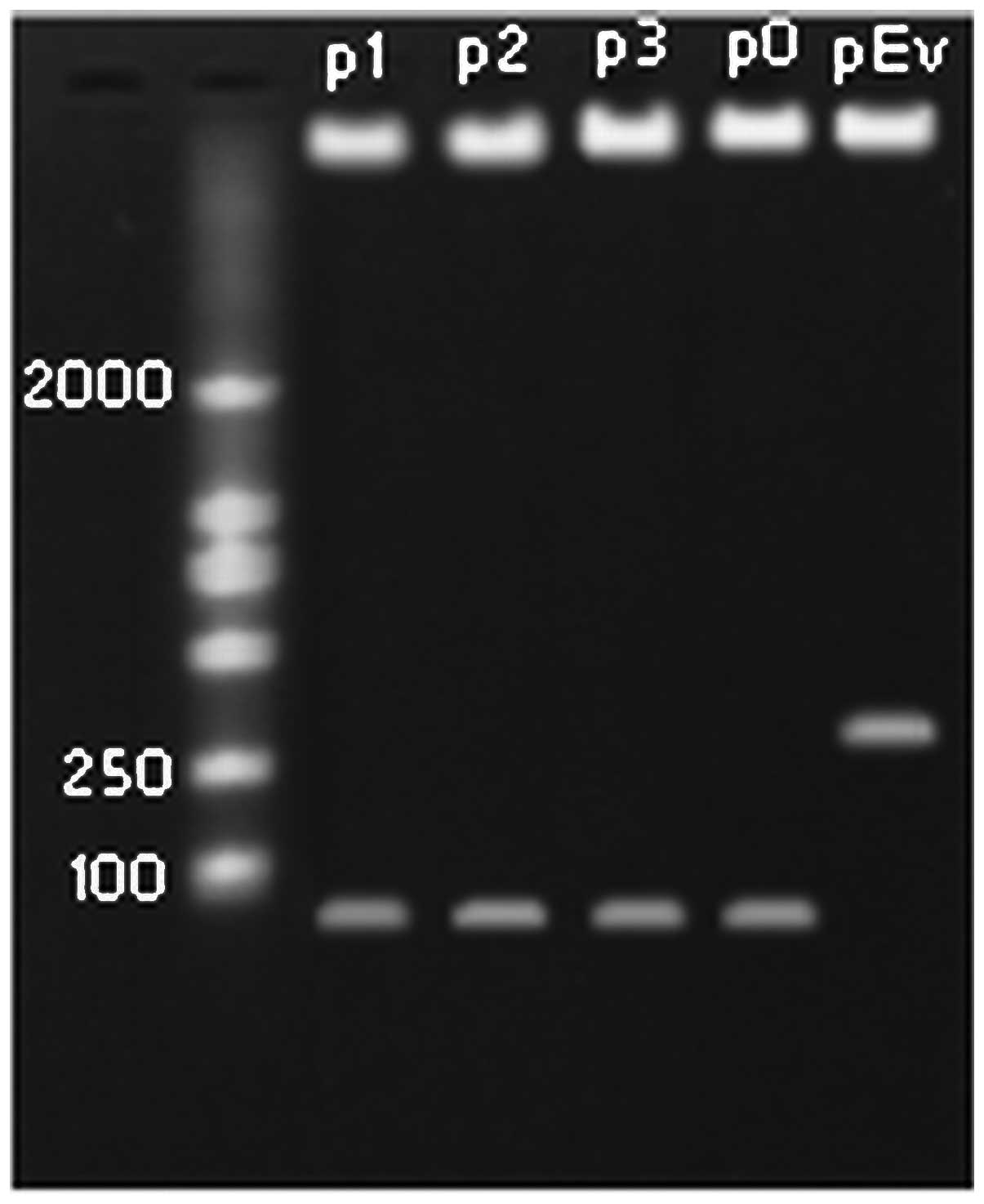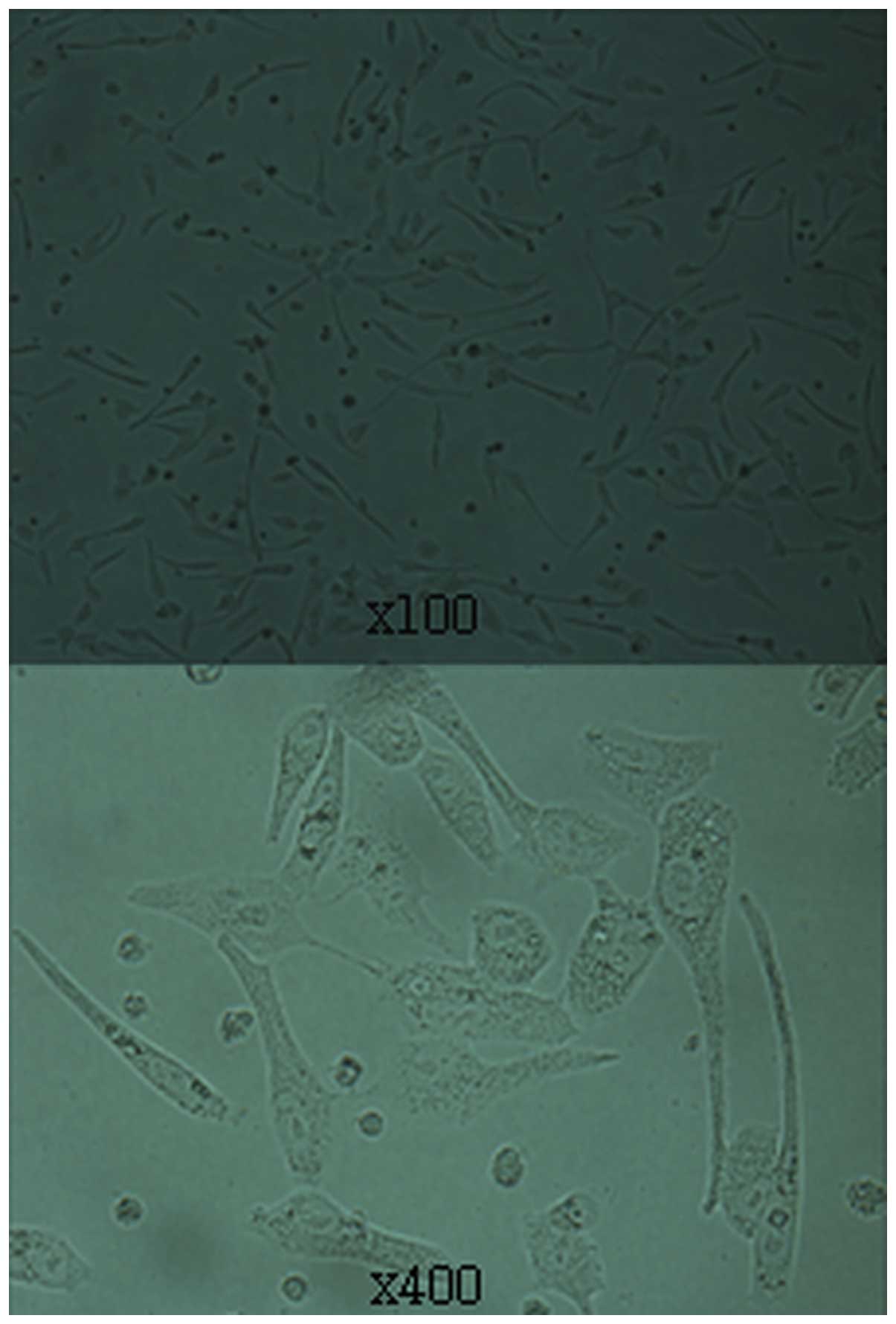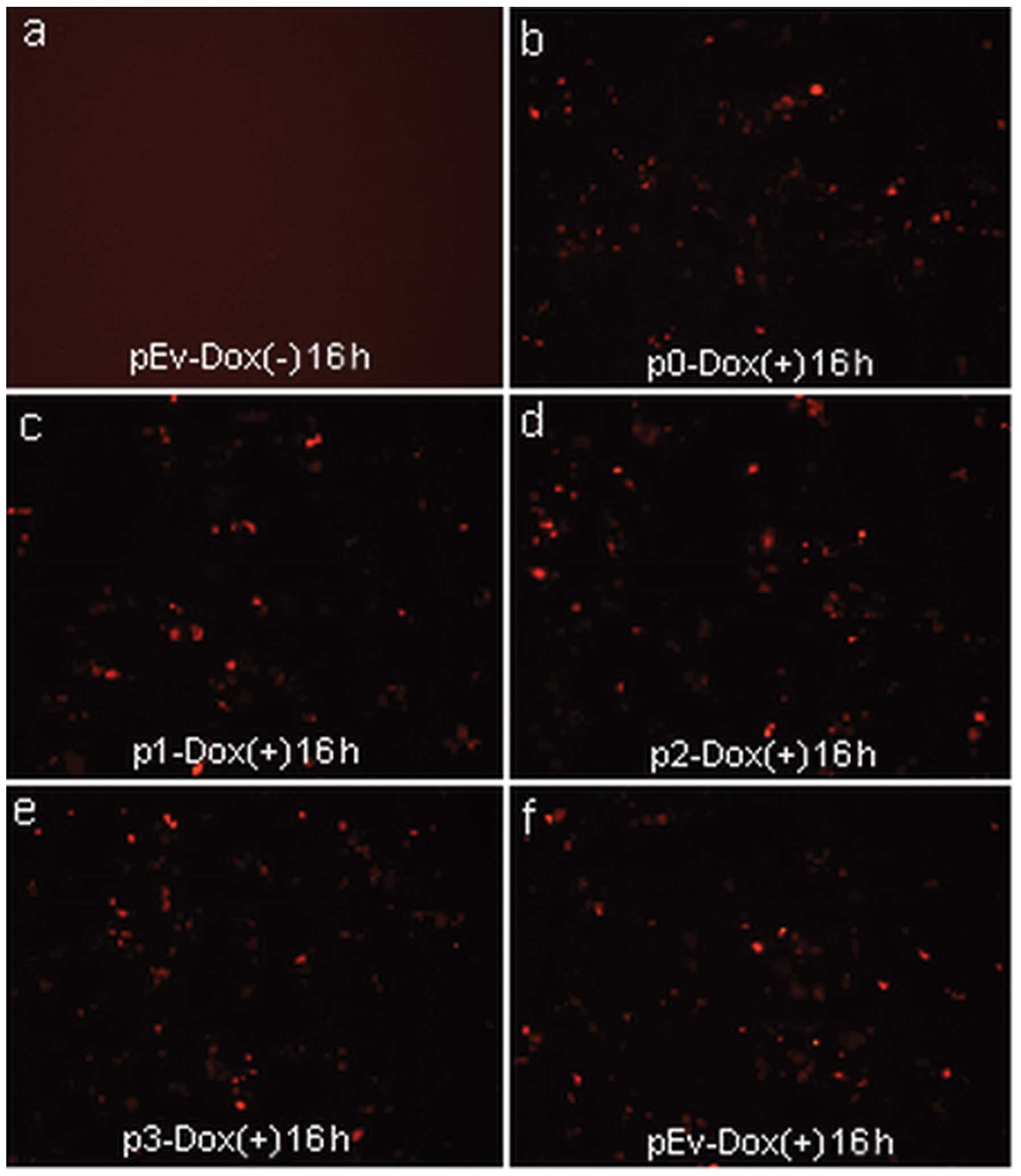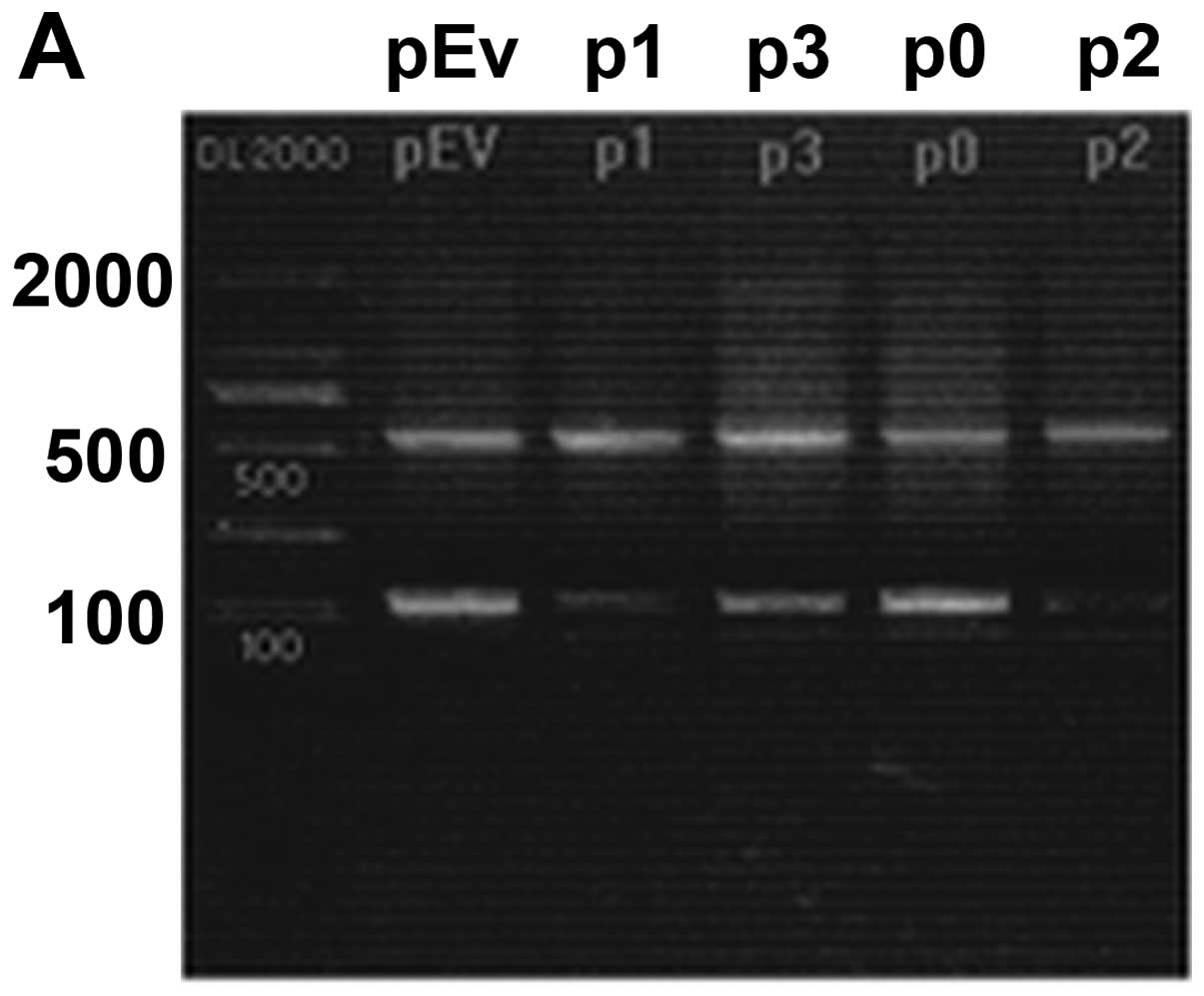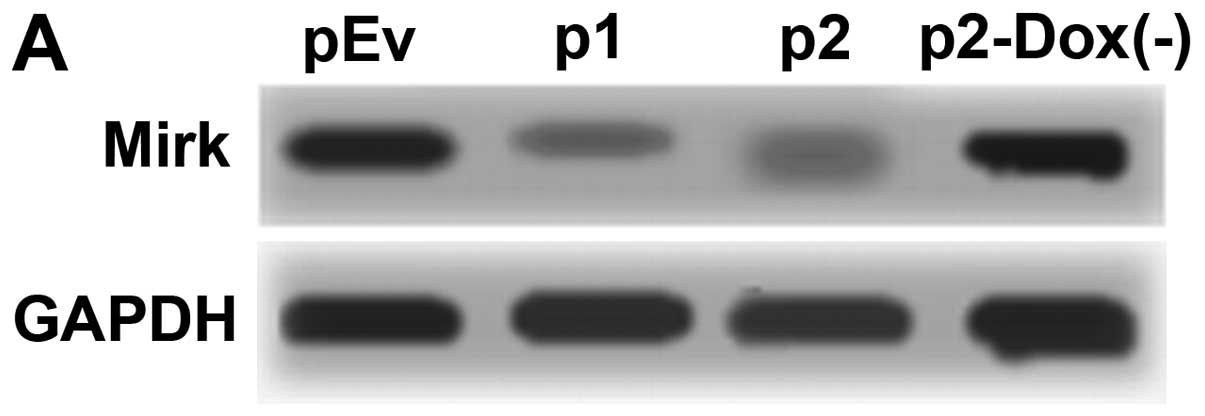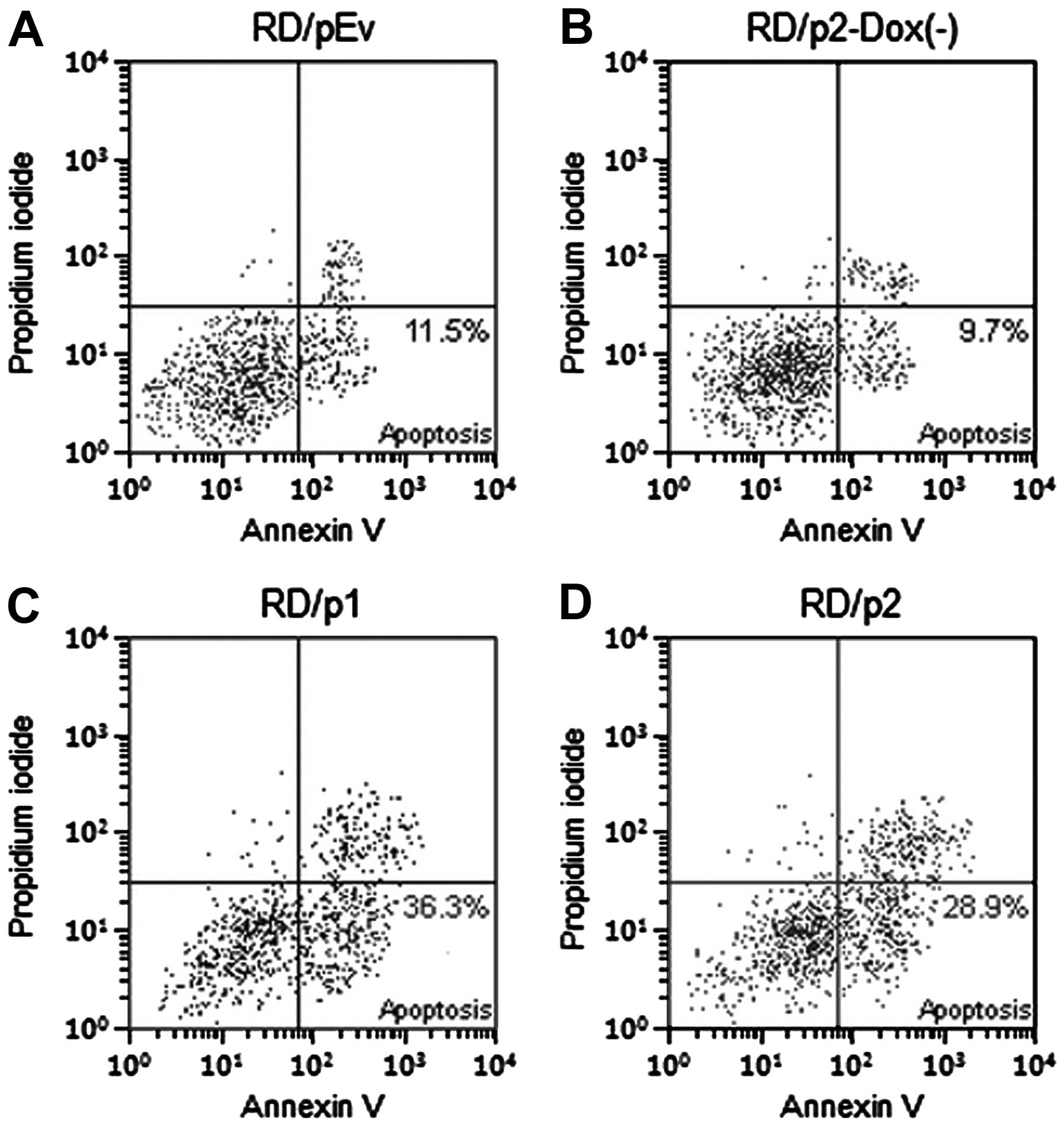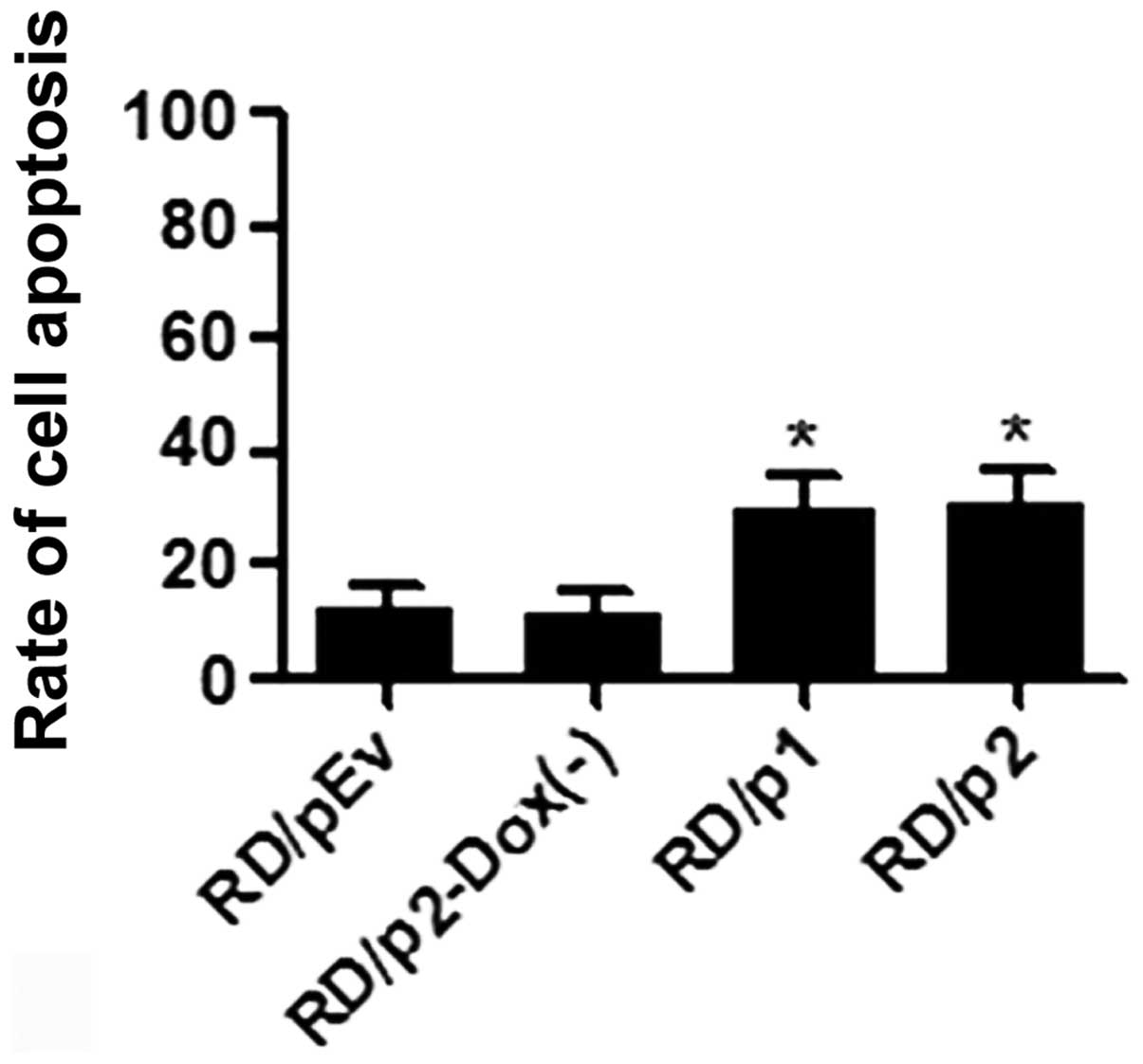Construction of conditional lentivirus-mediated shRNA vector targeting the human Mirk gene and identification of RNAi efficiency in rhabdomyosarcoma RD cells
- Authors:
- Published online on: August 2, 2013 https://doi.org/10.3892/ijo.2013.2048
- Pages: 1253-1259
Abstract
Introduction
Rhabdomyosarcoma (RMS) is a soft-tissue malignancy that is thought to arise from primitive mesenchymal cells of skeletal muscle lineage. It is the most common soft tissue sarcoma of childhood, accounting for ∼50% of all pediatric soft tissue sarcomas, although it is infrequent in adults (1).
The aetiology of RMS is unknown, but has been associated with growth factor pathways (2) and chromosomal translocations (3). It is demonstrated that Mirk is overexpressed in several solid tumors, including rhabdomyosarcoma, colon carcinoma, prostate carcinoma, pancreatic ductal adenocarcinoma and non-small cell lung carcinoma, where it may play a role in prosurvival signaling (4). Minibrain-related kinase (Mirk) is a member of the dual-specificity tyrosine-regulated kinase (Dyrk)/Minibrain family of dual-specificity protein kinases (5). Activation of the Dyrk family kinases is accomplished by autophosphorylation mediated by a transitional intermediate form of the nascent protein (6). The first primary function of Mirk to be elucidated using myogenesis as a model system was the role of Mirk as a G0 checkpoint kinase. Mirk is upregulated and activated in myoblasts arrested in G0 when they initiate differentiation (7). Since Mirk has limited expression in normal tissue with highest expression seen in skeletal muscle, heart, testes and brain (8), potential limitations of Mirk as a pharmacological target may arise from the pathophysiological consequences of inhibiting Mirk in normal tissues. To circumvent this potential limitation, it may be possible to design RNA interference(RNAi) tools that could specifically target the survival functions of Mirk in tumorigenic cells according to the differential functions and tissue distributions of the various splice variants of Mirk.
RNAi is a sequence-specific gene silencing process that occurs at the messenger RNA (mRNA) level. In mammalian cells short dsRNAs (<30 bp) trigger the specific knockdown of mRNAs in mammalian cells without interferon activation (9), based on the discovery above, silencing of gene expression by RNA interference (RNAi) is currently used as standard tool in cultured mammalian cells, which has demonstrated great prospects for human gene function, signal transduction research and gene therapy (10). Although chemically synthetic siRNAs can be introduced into cultured cells and induce the transient knockdown of target mRNAs, there is a clear problem in its use for stable transcript knockdown and a high efficiency of RNAi delivery. Alternatively, expression vectors driven by RNA polymerase III enable the permanent production of small dsRNAs in mammalian cells (11,12), furthermore the doxycycline-controlled tet-on lentiviral system can be used to reversibly induce gene silencing in a temporally and spatially restricted manner (13).
Since there is little research on the relationship between Mirk and tumor, and its function in tumor cells has not been clearly studied so far. In the present study, a Tet-on Lentivirus-mediated short hairpin RNA vector targeting human Mirk gene was designed, such vector-derived transcripts were processed by Dicer in a similar manner as siRNAs. Then we employed the constructed lentivirus vector mediating RNAi targeting of Mirk gene to study the influence of the knockdown of Mirk on rhabdomyosarcoma RD cells growth in vitro.
Materials and methods
Cell culture
Rhabdomyosarcomas RD and 293T cell lines were obtained from Chinese type culture collection (WuHan), they were both cultured in Dulbecco’s modified Eagle’s medium (DMEM) (Gibco) supplemented with 10% fetal bovine serum (FBS) (Gibco), 100 U/ml penicillin, and 100 mg/ml streptomycin (Invitrogen). Cells were incubated at 37°C in 5% CO2 atmosphere, the medium was refreshed every 2 or 3 days and passaged when confluent monolayers were achieved using trypsin solution.
Design of human Mirk-shRNA
The mRNA sequence of human Mirk (GenBank acc. no.: NM_004714) was placed in Ambion online RNAi Designer to design siRNA. Since not every working siRNA sequence is equally effective when incorporated into shRNA (14), we selected three optimal siRNAs in different target sequences. One scrambled shRNA control was specifically designed. All four sequences were aligned using the GenBank BLAST program, no other homologous sequences matched except the Mirk gene. To obtain the double-stranded RNA configuration required for short hairpin RNA formation from single-stranded RNA, we linked a 19-bp sense siRNA sequence to its complementary antisense sequence via a 9-bp loop region and combine it with additional two T nucleotides, which is flanked by restriction enzyme recognition sequences and their protective bases (15). Two complementary single-stranded DNA oligonucleotides of the four shRNAs were chemically synthesized by Shanghai Genechem Co. Ltd. These oligonucleotides were annealed to produce double-stranded oligonucleotides (Table I).
Construction of pTRIPz-Mirk-shRNA vectors
The annealed Mirk-shRNA oligonucleotides were cloned into linearized pTRIPZ empty vector (Open Biosystems catalog #RHS4750) using the following steps: the pTRIPZ vectors and double-stranded shRNA oligonucleotides were digested with both XhoI and Mlul, respectively; recycling the big fragment (13061 bp) of the former and the digested shRNA fragment (55 bp); and then ligated by T4 DNA ligase according to the manufacturer’s protocol. The ligated products were transformed into competent DH5a cells using heat shock method. The transformed cells were grown on an LB-agar plate containing ampicillin and neomycin.
Identification of double digestion and DNA sequence
To ensure that the shRNAs were inserted into the vectors. We collected positive clones and grew them at 37°C in LB broth (low salt) media plus 100 μg/ml ampicillin only, and incubation at 37°C for 18 h with vigorous shaking. The plasmid DNA was prepared using Plasmid mini kit (Qiagen) according to the manufacturer’s instructions. and restriction digested with XhoI and MluI using the plasmid DNA prepared and incubated at 37°C for 3 h, followed by digestion on a 1.5% agarose gel. Two bands were seen (55 bp and a large band near 13 kp). The extracted recombinant plasmids were used for DNA sequencing to identify the inserted Mirk-shRNA fragments. The pTRIPZ sequencing primer was: 5′-GGAAAGAATCAAGGAGG-3′.
Transfection and lentivirus production
Twenty-four hours before transfection, 293T packaging cells were seeded in a 6-well plate and cultured in growth medium without antibiotics to achieve ∼70% confluency in a cell culture dish and passaging at a 1:2 ratio for at least two consecutive days. For transfection, 6 μg pTRIPZ-Mirk-shRNA vector and 4.3 μl Trans-Lentiviral packaging mix (Fisher Scientific catalog no.: 14-959-1A) was used per well, which co-transfect into cells by using the calcium phosphate reagent according to the manufacturer’s instructions. Cells were incubated at 37°C with 5% CO2 for 12 h. Calcium phosphate-containing medium was removed from cells and replaced with the indicated volume of reduced serum medium (High Glucose DMEM 5% Fetal Bovine Serum 2 mM L-glutamine 1X penicillin-streptomycin). Viral particle-containing supernatants 64-h post-transfection were harvested by removing medium to a 15 ml sterile, capped, conical tube. Non-adherent cells and debris was pelleted by centrifugation at 1600 × g and 4°C for 10 min. Each viral titer was estimated as ×106 by counting the number of RFP 293T cells by flow cytometry two days after transduction with serial dilutions of the viral stocks. MOI of 0.3 was used.
Infection of target cells
In order to generate stable RD cell lines, we determined that the minimum amount of puromycin required to kill non-transduced cells is 1.1 μg/ml. We used the purified viral particle to infect rhabdomyosarcomas RD cells, as previously described (16). After 6 days under puromycin selection, the fresh complete medium containing doxycycline (0.5 μg/ml) was replaced in the cells, doxycycline-free group, empty vector group and scrambled shRNA vector group were used as controls. When the stable transgenic cells reached confluence, some were collected for RNA extraction to evaluate RNAi efficiency, and the rest were frozen in liquid nitrogen for further experiments.
Quantitative RT-PCR
Total RNA was extracted from the Rhabdomyosarcomas RD cells using the RNeasymini kit (Qiagen). RNA was digested by DNaseI to remove the contamination of DNA, and single-stranded cDNA was prepared from RNA using the High Capacity cDNA RT kit (Qiagen). Quantitative RT-PCR primers were designed using Beacon Designer. A reverse transcription PCR reaction was performed to screen the most effective recombinant plasmids. Real-time PCR was performed using LightCycler® 480 Gene Scanning software (Roche Applied Science, USA), as previously described (17). A standard PCR program was used for SYBR Green I: 95°C for 5 min; 45 cycles of 95°C for 10 sec, 55°C for 40 sec; followed by 95°C for 10 sec, 65°C for 1 min, and 95°C for 30 sec, melting curve analysis was performed to verify the identities of PCR products. Each sample was tested three times to obtain an average. Relative expression levels of Mirk gene were normalized to GAPDH expression levels. Primer sequences for amplification of Mirk and GAPDH are listed in Table II.
Western blot analysis
RD cells were lysed in 40 μl of 1X Radio Immunoprecipitation Assay Lysis Buffer (Sigma) on ice for 30 min. The lysates were cleared by centrifugation. Proteins were separated on SDS-PAGE (4% stacking gel, 12% separating gel) and transferred to nitrocellulose membranes, as previously described (18). The membranes were blocked with 5% skimmed milk in TS buffer (10 mm Tris-HCl, 150 mm NaCl, pH 7.4), then probed with anti-Mirk (Santa Cruz Biotechnology, Santa Cruz, CA, USA) and anti-GAPDH (Sigma, USA) at room temperature, followed by incubation with horseradish peroxidase-conjugated goat anti-mouse secondary antibody (Amersham Pharmacia Biotech). After several washes, the membranes were incubated with an enhanced chemiluminescence system (Invitrogen, USA) and exposed to Kodak Biomax light film. GAPDH protein levels were used as a control to verify equal protein loading.
Detection of apoptosis by flow cytometry and fluorescence microscopy
After transduction with lentivirus, stable RD cell lines were seeded in 6-well plates at a density of 2×104 cells per well. After 24 h Dox (0.5 μg/ml) was added, RD cells were harvested and washed in cold phosphate-buffered saline (PBS). Cell suspension with density of 1×106/ml was preparing for each assay. Cells were stained with fluorescein isothiocyanate (FITC) labeled Annexin V, and simultaneously with propidium iodide (PI) stain, as previously described (19), to discriminate intact cells (Annexin−/PI−) from apoptotic cells (Annexin+/PI−), and necrotic cells (Annexin+/PI+). FACS analysis for Annexin V and PI staining was performed by flow cytometery. All experiments were performed in triplicate.
Flow cytometry analysis of the cell cycle
The cells were harvested by trypsinization, fixed with cold 70% ethanol, and stored at 4°C until analyzed. The cells were resuspended in phosphate buffered saline (PBS) containing 10 μg/ml RNaseA and 20 μg/ml propidium iodide (PI) for 30 min at room temperature, and DNA content was detected by flow cytometry (BD, USA). The relative proportions of cells in the G1/G0, S and G2/M phases of the cell cycle were determined from the flow cytometry data.
Statistical analysis
The software of SPSS version 17.0 (SPSS Inc., IL, USA) was used for statistical analysis. Values shown are representative of triplicate determinations in no less than three experiments. Data are expressed as mean ± SD. Results were considered significant, if P<0.05 was obtained by a two-sided Student’s t-test.
Results
Sequencing profile of the recombinant Mirk-shRNA expression vectors
Schematic diagram for the construction of the pTRIPz-shRNA expression vector to knockdown Mirk is shown as shown in Fig. 1. Recombinant plasmids were digested with XhoI and MluI, and the fragments were identified on 1.5% agarose gel (Fig. 2). The results of DNA sequencing provided further confirmation of the presence of the recombinant plasmids, indicating that all the shRNA expression plasmids carried the correct sequence.
Generation of stable transgenic RD cells
Puromycin selection was used to obtain stable transfected RD cell lines from rhabdomyosarcomas. We noted that a few cells aged and lost their growing ability after puromycin selection. Well-grown colonies were passaged after puromycin selection, and then transferred to 60-mm culture dishes to facilitate expansion (Fig. 3). Expression of the reporter gene (RFP) was assessed by visualization of fluorescence (Fig. 4).
Silencing of Mirk mRNA and protein expression after lentivirus transduction
To exclude off-target silencing effect mediated by specific-shRNA, we designed three different Mirk-shRNAs (p1, p2 and p3) to silence the expression of Mirk gene in the RD cell line, with scrambled shRNA (p0) and empty vector (pEv) as controls. The mRNA levels of Mirk gene expression were determined by reverse transcription PCR (Fig. 5A) and real-time quantitative PCR (Fig. 5B). The screened p1 and p2 were the most effective groups. Then p1 and p2 were transduced into stable RD cells again, controls were pEv and p2-Dox(−). Protein levels of Mirk gene expression were determined by western blotting. As shown in Fig. 6A, compared with both pEv and p2-Dox(−) control groups, the protein levels of Mirk in p1 and p2 groups were significantly reduced respectively (P<0.05), but there was no obvious difference between the two controls (Fig. 6B).
Apoptosis was increased in RD cells by knockdown of endogenous Mirk
To ascertain whether apoptosis was increased in RD cells by the knockdown of Mirk, we used Annexin V-FITC and propidium iodide staining. Flow cytometric analysis was performed to evaluate apoptotic cells (Fig. 7). After silencing of Mirk was induced, the percentage of apoptotic cells in p1 and p2 groups is much greater than that in pEv and p2-Dox(−) groups (Fig. 8).
Mirk RNAi induces the changes of the cell cycle
In the current study, the effect of Mirk downregulation on the cell cycle of RD cells was determined and each assay was performed in triplicate. The flow cytometry analysis revealed that more RD cells in p1 and p2 groups were arrested in the G0/G1 phase of the cell cycle (65.8±2.3 and 67.8±1.8%, respectively), and the proliferation index (PI) of RD cells (44.4±4.1 and 41.4±3.4%, respectively) was decreased correspondingly (P<0.05), while there was no statistical difference between pEv and p2-Dox(−) groups, PI = (S+G2/M)/(G0/G1+G2/M) ×100% (Table III).
Discussion
Rhabdomyosarcoma (RMS) is generally diagnosed in younger children, 60% of cases are diagnosed in children younger than 5 years of age, nearly one-third of all RMS cases occur in the head and neck area (20). Current approaches of treatment include surgical removal, radiation and chemotherapy (21). However, both chemotherapy and radiotherapy sometimes are not sensitive to patients (22) and may result in facial growth retardation, neuroendocrine dysfunction of oral tissues, such as visual problems, hearing loss, delayed eruption of the teeth, hypodontia and velopharyngeal insufficiency (23,24). In addition, surgical resection of rhabdomyosarcoma is not always possible because of extent of disease and involvement of surrounding critical organs (25), which is challenging and can result in large maxillofacial defects with loss of function and esthetics of the surrounding tissues. In recent years, with the development of RNA interference (RNAi) technology, RNAi shows enormous potential in therapeutics for tumors (26).
RNAi constructs can be designed to target any known gene. As they make use of a conserved biological silencing pathway, they are a particularly effective method to inhibit aberrant gene expression that results in pathogenesis. The sequence specificity of the RNAi mechanism provides a high specificity required for targeted therapies, overcoming the side effects of several traditional therapies. Specific gene silencing can be achieved in many sorts of cell systems using chemically synthesized small interference RNA (siRNA) or DNA vector-based shRNA. Functional genomics using RNAi has facilitated the rate in which genes are assigned function and thereby expedited the identification of potential therapeutic targets for some gene related diseases (27–29). Importantly, several RNAi-based therapies are on the way to being developed (30). Doxycycline-controlled tet-on lentiviral system enables the reversible and body-wide expression of shRNAs (13,31) and offers the opportunity to reverse the induced gene knockdown at a given time. This property of the shRNA system offers unique applications to study gene function in animal experiments that cannot be achieved with knockout technologies (32,33). Although lentivirus vectors has been used for several years, the use of Tet-on lentiviral vector expressing shRNA as a therapeutic tool for rhabdomyosarcoma has not been clearly explored.
In this study, we used lentivirus-mediated RNAi to silence the endogenous Mirk expression and explored the effects of Mirk downregulation on the phenotypes of RD cells. We designed three shRNAs targeted at Mirk gene and successfully transfected them into rhabdomyosarcoma RD cell line by lentivirus. Since the inducible pTRIPz vector include a puromycin resistance gene, positive cell lines can be conveniently selected using puromycin. After stable integration, vectors expressing Mirk-shRNAs constitutively will directly induce downregulating of target gene with the control of doxycycline. Permanent Mirk gene silencing is achieved in RD cells by integrating shRNA transgenes into the genome. Mirk-shRNAs (p1, p2) have been identified as the most effective ones, because the stable transfectants show significantly decreased levels of Mirk mRNA and protein, which subsequently indicated that our constructional lentivirus-mediated Mirk-specific shRNA was able to silence the expression of Mirk effectively and specifically in RD cells. The efficiency of gene silencing can be as high as 60%.
In addition, we observed that the depletion of Mirk resulted in apoptosis in RD cells in vitro. Further research showed that most of the cells were arrested in G0/G1 phase. However, the mechanism has not been elucidated in detail. Mirk has been previously shown to mediate cell survival by binding to a variety of proapoptotic molecules, including procaspase-3 and apoptosis signaling kinase 1 (34,35) in colon carcinoma cells (8). A previous study has demonstrated the importance of kinases such as Mirk/Dyrk1B and Dyrk3 which were found to participate in prosurvival signaling (36). Mirk is likely to mediate tumor survival during periods when tumorigenic cells temporarily outgrow their nutrient support, and the Mirk-induced survival pathway may provide a strong selective pressure to maintain expression of Mirk in tumors and complement other survival pathways activated by growth factors such as fibroblast growth factors (4).
In conclusion, we established a conditional and effective method for screening the most effective shRNA for suppressing Mirk gene overexpression in rhabdomyosarcoma RD cell line and generated stable transgenic RD cell line for further study. This method is likely to be useful in exploring biochemical mechanisms of RNA interference pathways and it has the potential to provide more rational strategies for efficient targeting suppression of any desired gene. We also found that depletion of Mirk inhibited RD cells proliferation due to G0/G1 arrest and apoptosis. There is an increasing awareness that survival pathways in tumors are much more critical compared with normal progenitors. The evidence of Mirk to mediating cell survival in RMS suggests that it may have some potential as a pharmacological target. These results have paved the way for the study of the function of Mirk in tumor cells, and could be of great benefit for gene therapy in the future.
Acknowledgements
This work was supported by the National Natural Science Fund of China (no. 81072187). We are indebted to Professor Y. Liu for providing experimental supplies and technical assistance.
Reference
|
Ulutin C, Bakkal H and Kuzhan O: A cohort study of adult rhabdomyosarcoma: a single institution experience. World J Med Sci. 3:54–59. 2008. | |
|
Merlino G and Helman LJ: Rhabdmyosarcoma - working out the pathways. Oncogene. 18:5340–5348. 1999. View Article : Google Scholar : PubMed/NCBI | |
|
Barr FG: Molecular genetics and pathogenesis of rhabdomyosarcoma. J Paediatr Hematol Oncol. 19:483–491. 1997. View Article : Google Scholar : PubMed/NCBI | |
|
Mercer SE and Friedman E: Mirk/Dyrk1B-A multifunctional dual-specificity kinase involved in growth arrest, differentiation, and cell survival. Cell Biochem Biophys. 45:303–315. 2006. View Article : Google Scholar : PubMed/NCBI | |
|
Deng X, Ewton D, Pawlikowski B, et al: Mirk/Dyrk1B is a rho-induced kinase active in skeletal muscle differentiation. J Biol Chem. 278:41347–413003 | |
|
Lochhead PA, Sibbet G, Morrice N and Cleghon V: Activation-loop autophosphorylation is mediated by a novel transitional intermediate form of DYRKs. Cell. 121:925–936. 2005. View Article : Google Scholar : PubMed/NCBI | |
|
Becker W, Weber Y, Wetzel K, et al: Sequence characteristics, subcellular localization and substrate specificity of Dyrk-related kinases, a novel family of dual specificity protein kinases. J Biol Chem. 273:25893–25902. 1998. View Article : Google Scholar | |
|
Lee K, Deng X and Friedman E: Mirk protein kinase is a mitogen-activated protein kinase substrate that mediates survival of colon cancer cells. Cancer Res. 60:3631–3637. 2000.PubMed/NCBI | |
|
Elbashir SM, Harborth J, Lendeckel W, et al: Duplexes of 21-nucleotide RNAs mediate RNA interference in cultured mammalian cells. Nature. 411:494–498. 2001. View Article : Google Scholar : PubMed/NCBI | |
|
Karagiannis TC and El-Osta A: siRNAs: mechanism of RNA interference, in vivo and potential clinical applications. Cancer Biol Ther. 3:1069–1074. 2004. View Article : Google Scholar : PubMed/NCBI | |
|
Brummelkamp TR, Bernards R and Agami R: A system for stable expression of short interfering RNAs in mammalian cells. Science. 296:550–553. 2002. View Article : Google Scholar : PubMed/NCBI | |
|
Paddison PJ, Caudy AA, Bernstein E, et al: Short hairpin RNAs (shRNAs) induce sequence-specific silencing in mammalian cells. Genes Dev. 16:948–958. 2002. View Article : Google Scholar : PubMed/NCBI | |
|
Seibler J, Kleinridders A, Küter-Luks B, et al: Reversible gene knockdown in mice using a tight, inducible shRNA expression system. Nucleic Acids Res. 35:e542007. View Article : Google Scholar : PubMed/NCBI | |
|
Reynolds A, Leake D, Boese Q, et al: Rational siRNA design for RNA interference. Nat Biotechnol. 22:326–330. 2004. View Article : Google Scholar : PubMed/NCBI | |
|
Barøy T, Sørensen K, Lindeberg MM and Frengen E: shRNA expression constructs designed directly from siRNA oligonucleotide sequences. Mol Biotechnol. 45:116–120. 2010.PubMed/NCBI | |
|
Das AT and Zhou X: Viral evolution as a tool to improve the tetracycline-regulated gene expression system. J Biol Chem. 279:18776–18782. 2004. View Article : Google Scholar : PubMed/NCBI | |
|
Nolan T, Hands RE and Bustin SA: Quantification of mRNA using real-time RT-PCR. Nat Protoc. 1:1559–1582. 2006. View Article : Google Scholar : PubMed/NCBI | |
|
Ghaemmaghami S, Huh WK, Bower K, et al: Global analysis of protein expression in yeast. Nature. 425:737–741. 2003. View Article : Google Scholar : PubMed/NCBI | |
|
Riccardi C and Nicoletti I: Analysis of apoptosis by propidium iodide staining and flowcytometry. Nat Protoc. 1:1458–1461. 2006. View Article : Google Scholar : PubMed/NCBI | |
|
Arndt CA, Rose PS, Folpe AL and Laack NN: Common musculo-skeletal tumors of childhood and adolescence. Mayo Clin Proc. 87:475–487. 2012. View Article : Google Scholar : PubMed/NCBI | |
|
Fyrmpas G, Wurm J, Athanassiadou F, et al: Management of paediatric sinonasal rhabdomyosarcoma. J Laryngol Otol. 123:990–996. 2009. View Article : Google Scholar : PubMed/NCBI | |
|
Fatusi OA, Ajike SO, Olateju SO, et al: Clinicoepidemiological analysis of orofacial rhabdomyosarcoma in a Nigerian population. Int J Oral Maxillofac Surg. 38:256–260. 2009. View Article : Google Scholar : PubMed/NCBI | |
|
Kaste SC, Goodman P, Leisenring W, et al: Impact of radiation and chemotherapy on risk of dental abnormalities: a report from the Childhood Cancer Survivo Study. Cancer. 115:5817–5827. 2009. View Article : Google Scholar : PubMed/NCBI | |
|
Estilo CL, Huryn JM, Kraus DH, et al: Effects of therapy on dentofacial development in long-term survivors of head and neck rhabdomyosarcoma: the memorial sloan-kettering cancer center experience. J Pediatr Hematol Oncol. 25:215–222. 2003. View Article : Google Scholar : PubMed/NCBI | |
|
Paulino AC and Okcu MF: Rhabdomyosarcoma. Curr Probl Cancer. 32:7–34. 2008. View Article : Google Scholar | |
|
Stevenson M: Therapeutic potential of RNA interference. N Engl J Med. 351:1772–1777. 2004. View Article : Google Scholar : PubMed/NCBI | |
|
Hannon GJ and Rossi JJ: Unlocking the potential of the human genome with RNA interference. Nature. 431:371–378. 2004. View Article : Google Scholar : PubMed/NCBI | |
|
Ito M, Kawano K, Miyagishi M and Taira K: Genome-wide application of RNAi to the discovery of potential drug targets. FEBS Lett. 579:5988–5995. 2005. View Article : Google Scholar : PubMed/NCBI | |
|
Silva J, Chang K, Hannon GJ and Rivas FV: RNA-interference-based functional genomics in mammalian cells: reverse genetics coming of age. Oncogene. 23:8401–8409. 2004. View Article : Google Scholar : PubMed/NCBI | |
|
Samakoglu S, Lisowski L, Budak-Alpdogan T, et al: A genetic strategy to treat sickle cell anemia by coregulating globin transgene expression and RNA interference. Nat Biotechnol. 24:89–94. 2006. View Article : Google Scholar : PubMed/NCBI | |
|
Kotnik K, Popova E, Todiras M, et al: Inducible transgenic rat model for diabetes mellitus based on shRNA-mediated gene knockdown. PLoS One. 4:e51242009. View Article : Google Scholar : PubMed/NCBI | |
|
Christoph T, Bahrenberg G, De Vry J, et al: Investigation of TRPV1 loss-of-function phenotypes in transgenic shRNA expressing and knockout mice. Mol Cell Neurosci. 37:579–589. 2008. View Article : Google Scholar : PubMed/NCBI | |
|
Sacca R, Engle SJ, Qin W, et al: Genetically engineered mouse models in drug discovery research. Methods Mol Biol. 602:37–54. 2010. View Article : Google Scholar : PubMed/NCBI | |
|
Asada M, Yamada T, Ichijo H, et al: Apoptosis inhibitory activity of cytoplasmic p21(Cip1/WAF1) in monocytic differentiation. EMBO J. 18:1223–1234. 1999. View Article : Google Scholar : PubMed/NCBI | |
|
Blagosklonny MV: Are p27 and p21 cytoplasmic oncoproteins? Cell Cycle. 1:391–393. 2002. View Article : Google Scholar : PubMed/NCBI | |
|
Mackeigan JP, Murphy LO and Blenis J: Sensitized RNAi screen of human kinases and phosphatases identifies new regulators of apoptosis and chemoresistance. Nat Cell Biol. 7:591–600. 2005. View Article : Google Scholar : PubMed/NCBI |



